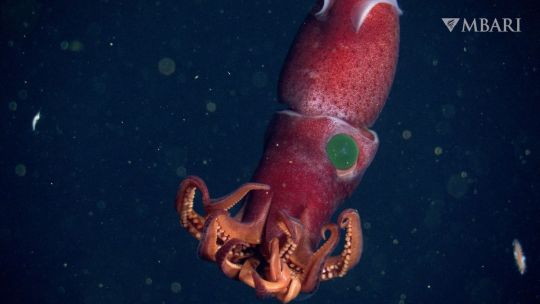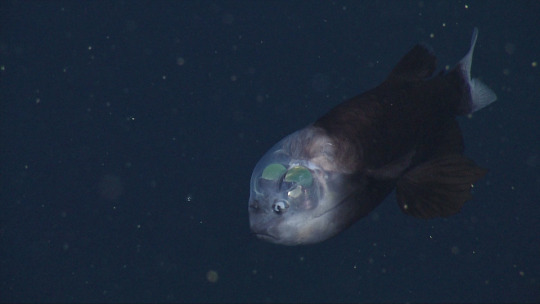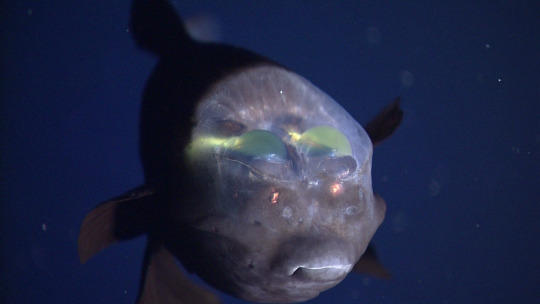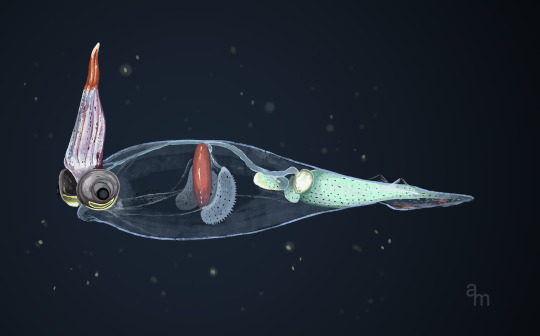#MBARI
Text
Shining a light on the origins of bioluminescence ✨✨
A new study led by MBARI collaborators at the Smithsonian’s National Museum of Natural History explores the evolution of bioluminescence, nature’s living light show. A team of researchers, including MBARI Senior Scientist Steven Haddock, has learned bioluminescence first evolved in animals at least 540 million years ago in soft corals.
Scientists have long been curious about the evolution of bioluminescence. To tackle the larger question of why bioluminescence evolved, we needed to know when this ability first appeared in animals. In search of the trait’s earliest origins, the team decided to peer back into the evolutionary history of octocorals, an ancient and frequently bioluminescent group of animals that includes soft corals, sea fans, and sea pens.
Mapping out the branches of the evolutionary tree from fossil records, genetics, and bioluminescent behaviors revealed that some 540 million years ago, the common ancestor of all octocorals was very likely bioluminescent. That is 273 million years earlier than the glowing ostracod crustaceans that previously held the title of earliest evolution of bioluminescence in animals.
MBARI’s Biodiversity and Biooptics Team is working to understand how and why animals produce their stunning luminescence.
Learn more about this illuminating research on our website.
91 notes
·
View notes
Text
What's not to love about the bloody-belly comb jelly?
Its crimson colors and dazzling diffraction have us swooning all year long. 😍😍😍
🎥: Deepest thanks to our research partners @mbari_news for the deep-sea footage!
3K notes
·
View notes
Text



An extraordinary deep-sea sighting: The giant phantom jelly (MBARI Monterey Bay Aquarium Research Institute)
#jellyfish#nature#sea#ocean#deep sea#biology#marine#marine biology#giant phantom jelly#science#MBARI
3K notes
·
View notes
Photo

Weird-eyed strawberry squid
MBARI researchers caught a glimpse of a bright red squid with peculiar peepers. The strawberry squid (Histioteuthis heteropsis) had one large bulbous yellow eye, while the other was small and black.
(Image credit: 2022 MBARI)
65 notes
·
View notes
Text

Sciartober Day 31: And the last one goes to the owlfish for the prompt: dark. There are only video reference for this animal along with a few illustrations, but I wanted to do something from one of MBARI's videos. I corrected the forehead to be less sloped, though the mouth might still be too big for this particular fish. Pentel brushpen, Windsor & Newton fine-line marker, and Prismacolor fine-line marker on Canson mixed media.
#Sciartober#Sciartober 2023#SciartoberDay31#deep sea#MBARI#owlfish#fish#animal#Bathylagidae#Osteichthyes#bony fish#art#my art#sciart#October drawings#October drawings 2023#pen and ink#black and white
28 notes
·
View notes
Text
youtube
I love a good creep.
Mothman. Jersey devil. Creature from the black lagoon.
But those are all imaginary creeps.
Today I'd like to introduce you to a real one: Grimalditeuthis
This squid has a modified tentacle with what looks like a little squid at the end. Usually the ends of squid tentacles (called the clubs) have suction cups with hooks or rings of teeth on the border of the suction cup. Not Grimalditeuthis! They have a creepy little squid puppet that scientists hypothesize is used as a lure. Attack my baby squid puppet? You're dinner.
Video by the Monterey Bay Aquarium Research Institute!
#deep sea#MBARI#Squid#cephalopod#marine biology#science#cephalopods#squid#sealife#marine life#scicomm#creep#spooky#spooky season#Youtube
174 notes
·
View notes
Note
beep boop squid soup
bloop bloop underwater squids (does the ocean count as soup?)
youtube
88 notes
·
View notes
Text
For #WomensHistoryMonth, here is the official portrait of Julie Packard (b. 1953) from the Monterey Bay Aquarium and MBARI
now in the permanent collection of the Smithsonian National Portrait Gallery:


Artist: Hope Gangloff, born 1974
Sitter: Julie Packard, born 1953
Date: 2019
Type/Medium: Painting, Acrylic on canvas
Dimensions in Frame: 212.1 × 141 × 6.4 cm (83 1/2 × 55 1/2 × 2 1/2")
Smithsonian National Portrait Gallery NPG.2019.3
#Julie Packard#Monterey Bay Aquarium#MBARI#aquarium#ocean conservation#marine conservation#portrait#painting#American art#contemporary art#2010s#Smithsonian National Portrait Gallery#Womens History Month#women artists#women in science#womein in STEM#museum visit#animals in art
30 notes
·
View notes
Text
Weirdest eyes in the deep
Ive been in fishbrain mode recently so I am here to tell you about one of my favorite deep-sea fish!

This guy is the barreleye fish (Macropinna microstoma), and it's got one of the weirdest eye adaptations out there--probably even weirder than the strawberry squid! Those little gray things that look like its eyes are actually its olfactory organs (basically fish nostrils); the weird green orbs you can see through the top of its head are its real eyes!

Absolute freak. Absolute CREATURE.
The purpose of this weirdass adaptation is actually very similar to the Histioteuthis' weird eyes (explained here); while Histioteuthis squids swim sideways with one eye looking up and one looking down, barreleye fish can ROTATE THEIR EYES IN THEIR FUCKING HEAD. THEY CAN LOOK FORWARDS OR UP BECAUSE THEY CAN ROTATE THEIR FUCKING EYES NINETY DEGREES. IN THEIR CLEAR FUCKING HEAD DOME.
Ok. I will be normal now. The consequence of them having a clear head is that their entire brain is visible; not exposed to the water outside, but apparently you can see it if you can distinguish it from all the other stuff in there. The dome is full of fluid, which keeps it from collapsing in the enormous pressure of their environment--these fish have been spotted from 2,000 feet (600 meters) to 2,600 feet (800 meters). While little is known about their diet, MBARI researchers Bruce Robinson and Kim Reisenbichler have observed barreleye fish rotating their eyes forwards to eat small fish and jellyfish, and Robinson speculated that they may steal food from siphonophores (which are even weirder animals--I'll post about them later).
Here's my favorite part about these fuckers, though: they're only six inches long!! when I first learned about them I assumed they were big guys but no!!! They're six inches long!!!!!!
More information on these guys can be found here (MBARI article about the fish) and here (short video narrated by Bruce Robinson) (Yes both of these are MBARI sources but they genuinely lead the world in deep-sea research and are great at making their information acessible; you should definitely check them out and, if you live in California, consider visiting the monterey bay aquarium!)
#lich says shit#ocean tag#i should really make a specific tag for these posts#uhhh.#science communication#sure. thars the tag#MBARI#barreleye fish#deep sea
8 notes
·
View notes
Text
one of my favorite things about the internet:
internet radio stations
My most favorite stations (links to apple music.app compatible URLs in parentheses):
The Lake Radio (http://hyades.shoutca.st:8627/stream)
FIP Jazz (https://icecast.radiofrance.fr/fipjazz-hifi.aac?id=radiofrance)
MBARI Hydrophone on the ocean bottom in Monterrey Bay Canyon (https://shoutcast.mbari.org/pacific-soundscape)
You can take the stream URLs and (in the apple Music.app) go to File -> Open Stream URL and they'll play. And then you can go to the top where it shows what's playing and click the ... and add it to a playlist for easy access.
what are your fav internet radio stations
#at the time of posting the whales are singing#they're not always there but when they are it's most often at night#whalesong#whales#monterrey bay#mbari#ocean exploration#hydrophone#the lake radio#fip jazz#internet radio stations#listening to FIP Jazz has really shown me how boring and antiquated my local 'jazz' station is#it's a 'golden oldies' station but for jazz#but FIP Jazz has a lot of stuff from the last year or two and it's so good and interesting#my blog
3 notes
·
View notes
Text
You don't have to be a solarpunk—or a lunarpunk—to dream of bioluminescence, from twinkling phytoplankton to glowing lamps, phosphorescent fungi, and jellyfish lit up like space ships. To honor those dreams, we talked to Dr. Steve Haddock, Senior Scientist at the Monterey Bay Aquarium Research Institute (MBARI) and leading expert on the things that glow, flash, and train headlights through the dark waters of the deep sea. Join us for this conversation about how bioluminescence works, what critters are capable of it and what they use it for, and whether or not our visions of bioluminescent street lamps stand a chance of coming true.
You can also follow Steve Haddock on Twitter @beroe and learn more about bioluminescence at https://biolum.eemb.ucsb.edu/.
Connect with Solarpunk Magazine at solarpunkmagazine.com and on Twitter @solarpunklitmag
Connect with Solarpunk Presents Podcast on Twitter @SolarpunkP, Mastodon @[email protected], or at our blog https://solarpunkpresents.com/
Connect with Ariel at her blog, on Twitter at @arielletje, and on Mastodon @[email protected]
Connect with Christina at her blog, on Twitter @xtinadlr, and on Mastodon @[email protected]
#solarpunk#lunarpunk#bioluminescence#ocean science#Dr Steve Haddock#solarpunk presents#solarpunk futures#podcast#Monterey Bay Aquarium Research Institute#MBARI#biomimicry#technology#futurism#Christina#season one episode seven
3 notes
·
View notes
Text
youtube
Too often, MBARI’s advanced underwater robots encounter trash.
Even miles beneath the ocean’s surface we find garbage, much of it plastic. Plastic pollution puts deep-sea animals at risk. On the seafloor, bags and other plastic trash can smother marine life. In the midwater, drifting debris can entangle or choke animals or damage their delicate structures.
Over time plastic trash breaks down into smaller and smaller bits and pieces called microplastic. Microplastics have been found throughout the ocean, from the surface to the seafloor. We still don't understand how microplastics are impacting marine communities. MBARI research is revealing our close connection to the ocean—how it sustains us and how human actions affect marine animals and environments.
To protect the amazing animals of the deep, we need to stem the tide of plastic pollution. Single-use plastic items—like water bottles, takeout containers, coffee lids, straws, and shopping bags—make up a large percent of plastic waste. By refusing plastic packaging and choosing reusable alternatives, we can make a significant dent in ocean plastic pollution. Learn more about trash in the deep sea on our website.
Learn what you can do from MBARI’s education and conservation partner, the Monterey Bay Aquarium.
76 notes
·
View notes
Text
Meet the extraordinary bone-eating worms: no eyes, no legs, no mouth, no stomach—no problem!
These deep-sea tube-dwellers have mastered the art of feasting on the bones of sunken whale carcasses. They secrete acid that dissolves the bone, while symbiotic bacteria aid in digesting the organic material, providing a unique food source for these fascinating creatures.
Our partners @mbari_news discovered these incredible worms more than two decades ago, and with their help, we’ve been able to bring them to our Into the Deep/En lo Profundo exhibit.
2K notes
·
View notes
Video
youtube
Monterey Bay Canyon, 402m, female of unknown TL, MBARI
2 notes
·
View notes
Photo

Squid mom carries pearl-like eggs
Extremely rare footage of a squid mom carrying a gelatinous string of glimmering pearl-like eggs in her arms was captured in the dark ocean depths off the California coast.
MBARI researchers spotted the deep-sea squid (an unknown species in the genus Bathyteuthis) with an ROV around 56 miles (90 kilometers) off the coast at a depth of 4,560 feet (1,390 meters).
(Image credit: Courtesy of MBARI)
61 notes
·
View notes
